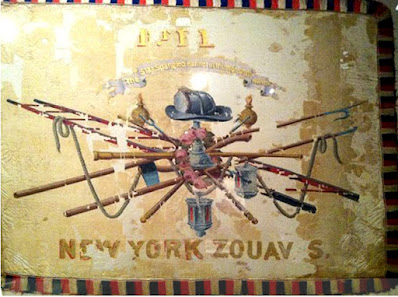Ladies Aid Album #3: Floral Cockade by Becky Brown
We can look at this eight-lobed design as a cockade,
a handmade show of support for the the Union or the Confederacy,
quite fashionable in the war's early days.
Woman wearing a cockade
Francis Brownell (1840-1894) of Troy, New York joined the 11th
New York Volunteers, the Fire Zouaves, in the first weeks
of the Civil War.
Zouave troops adopted a special uniform: a bolero style jacket, a colorful sash and short baggy trousers tucked into puttees, based on Algerian soldiers' outfits by way of France. Some Zouaves wore fez head gear.
Two fez-wearing New York Zouaves perhaps from a rival unit
Duryea's Zouaves
Frank Brownell in his more conventional hat, a kepi, wears decorations on his chest
although the war had just begun. (He eventually received
a medal of honor.) Two ornaments look like cloth cockades.
Union cockade with George Washington
Floral Cockade by Barbara Schaffer
Elmer Ephraim Ellsworth (1837-1861)
a New Yorker who studied law in Illinois
with Abraham Lincoln, accompanied
the new President to Washington.
Brownell was one of many New Yorkers eager to join the Zouaves in the first glorious weeks of the war when Elmer Ellsworth recruited troops in New York City. In April, 1861 days after Fort Sumter, women's work was to wave handkerchiefs at departing troops and present them with flags (either hand stitched or purchased from flag manufacturers.)
Charlotte Augusta Gibbes Astor (1825-1887)
By John Sully. She was born in Charleston, South Carolina.
Mrs. John Jacob Astor III was at New York society's pinnacle. Her husband had made a first fortune in fur trading, a second in New York real estate. She immediately commenced war work, commissioning flags for the Zouaves and presenting them to the troops in a ceremony on April 30th. (Genteel women did NOT speak to "mixed" groups so General John Adams Dix read her patriotic address to the soldiers.)
Four flags were presented; Charlotte Astor (called Augusta) presented a national flag and a regimental flag. "Ladies of the Astor House" (the family hotel) presented one and the New York Fire Department, from which many of the soldiers came, added a fourth.
The Astor House Hotel on Fifth Avenue, 1867
"The Ladies of the Astor House" (Did they live there or meet there?)
Floral Cockade by Barbara Brackman
All dots
General John Jacob Astor III
The Fire Department's contribution was described in the newspaper:
A Motto at the top "The Star Spangled Banner in triumph shall wave" and
images of a helmet, a hook and ladder...
And remarkably, the Fire Department's regimental flag has survived in the collection of the Flag Room at the state capitol in Albany. A rose wreath holds the tools in the center.
A few years ago that flag museum exhibited Zouave flags.
In mid-July New York's women continued their war work, presenting a hand-sewn flag.
Floral Cockade by Denniele Bohannon
By July Elmer Ellsworth was dead, shot in Alexandria, Virginia. The young Colonel's death shocked everyone from Lincoln to the children who idolized him.

Stationed in Washington Ellsworth was infuriated by a Confederate flag flying over James Jackson's Alexandria inn visible from the White House and all of the Union capitol. He decided to remove a Confederate symbol by storming Jackson's house. Jackson killed Ellsworth and Frank Brownell shot Jackson. The killing had begun.
Scraps of "Ellsworth's Flag" were snipped as souvenirs....
The fate of many flags
The Block
A better picture. The sun came out!
Floral Cockade by Bettina Havig
Rosettes like cockades were a fashionable New York pattern
early in the album fad.
From an album by Elizabeth Jennings Hopkins of Port Jefferson, Long Island,
New York---based on six lobes. See the whole quilt below.
Our pattern is based on eight (easier to fold and cut.)

Found in a sampler dated 1847 from Maltaville, New York
The Maltaville ablum has several cockade-like blocks.
Print this out on an 8-1/2" x 11" sheet.
Private Charles Sanford Hopkins of Duryea's Zouaves
Virginia Historical Society
Charles Hopkins was another Zouave who did not come home. His poor mother Elizabeth Jennings Hopkins (1824-1904), who made a New York album in the collection of the Denver Art Museum, lost eight of her nine children before they were 25 years old .




















































